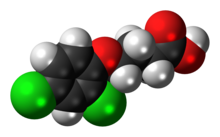2,4-DB or 4-(2,4-dichlorophenoxy)butyric acid is a selective systemic phenoxy herbicide used to control many annual and perennial broad-leaf weeds in alfalfa, peanuts, soybeans, and other crops. Its active metabolite, 2,4-D, inhibits growth at the tips of stems and roots. It is classified in toxicity class III. It shows some evidence of toxicity to dogs and cats, such as changes in body weight and reduced numbers of offspring, when fed 25-80 milligrams per kilogram of body weight for prolonged periods. Tests of carcinogenicity in this range yielded differing results. It is moderately toxic to fish.[1]

| |

| |
| Names | |
|---|---|
| Preferred IUPAC name
4-(2,4-Dichlorophenoxy)butanoic acid | |
Other names
| |
| Identifiers | |
3D model (JSmol)
|
|
| 1976809 | |
| ChEBI | |
| ChemSpider | |
| ECHA InfoCard | 100.002.152 |
| KEGG | |
PubChem CID
|
|
| RTECS number |
|
| UNII | |
| UN number | 3082 |
CompTox Dashboard (EPA)
|
|
| |
| |
| Properties | |
| C10H10Cl2O3 | |
| Molar mass | 249.09 g/mol |
| Appearance | Colorless to white crystal |
| Melting point | 117 to 119 °C (243 to 246 °F; 390 to 392 K) |
| 46 mg/L | |
| Hazards | |
| Occupational safety and health (OHS/OSH): | |
Main hazards
|
Persistent hazard to marine life. |
| GHS labelling: | |
 
| |
| Warning | |
| H302, H411[2] | |
| P264, P270, P273, P301+P312, P330, P391, P501[2] | |
| NFPA 704 (fire diamond) | |
| Lethal dose or concentration (LD, LC): | |
LC50 (median concentration)
|
1.97 mg/L - 96.0 h (Rainbow Trout)[2] |
| Safety data sheet (SDS) | Sigma-Aldrich Site |
Except where otherwise noted, data are given for materials in their standard state (at 25 °C [77 °F], 100 kPa).
| |
References
edit- ^ a b "Extension Toxicology Network: Pesticide Information Profiles". Archived from the original on 10 May 2008. Retrieved 15 June 2008.
- ^ a b c d "2,4-DB SDS". Sigma-Aldrich. Sigma Aldrich. Retrieved 14 May 2018.
